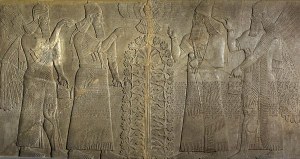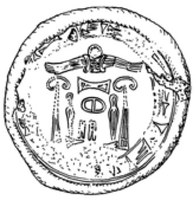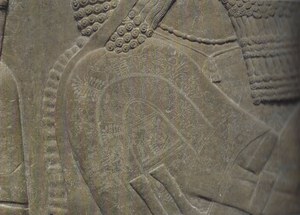Expansionist Politics and the Creation of an Emblem of Universal Kingship
This article appeared in ISAW Newsletter 23, Winter 2019.
 Wall relief from the Throne Room in Ashurnasirpal II’s Northwest Palace at Nimrud showing the sacred tree flanked by two representations of the king who again is accompanied by genii performing pollination (British Museum 124531). Image courtesy of the British Museum.
At the end of the third millennium BCE, in his famous hymn accounting the renovation of the temple of the warrior god Ningirsu, Gudea, ruler of Lagash, relates how Ningirsu and his consort Bau took possession of his new residence. The gods’ arrival was celebrated with a theogamy of the couple in their bedchamber that had been sumptuously adorned by the king. The hymn expounds on how the divine union generated abundance in the rivers, marshes, sheepfolds, and the entire land. This early royal account of creating the cultic context for the divine marriage and the divine response by providing the land with abundance and prosperity sets the stage for our interpretation of the symbol of the sacred tree, which, in Assyria, came to be represented as a palm tree during the second half of the second millennium BCE, and which developed into a central element of Assyrian iconography.
Wall relief from the Throne Room in Ashurnasirpal II’s Northwest Palace at Nimrud showing the sacred tree flanked by two representations of the king who again is accompanied by genii performing pollination (British Museum 124531). Image courtesy of the British Museum.
At the end of the third millennium BCE, in his famous hymn accounting the renovation of the temple of the warrior god Ningirsu, Gudea, ruler of Lagash, relates how Ningirsu and his consort Bau took possession of his new residence. The gods’ arrival was celebrated with a theogamy of the couple in their bedchamber that had been sumptuously adorned by the king. The hymn expounds on how the divine union generated abundance in the rivers, marshes, sheepfolds, and the entire land. This early royal account of creating the cultic context for the divine marriage and the divine response by providing the land with abundance and prosperity sets the stage for our interpretation of the symbol of the sacred tree, which, in Assyria, came to be represented as a palm tree during the second half of the second millennium BCE, and which developed into a central element of Assyrian iconography.
 Drawing of the aedicule seal of Suppiluliuma I.
With the far reaching expansion of Assyria to the West, during the ninth century BCE under King Ashurnasirpal II (883-859 BCE), a programmatic icon was created to express the notion of universal control. The iconographic configuration is reminiscent of the Hittite royal aedicule seals which, with the expansion of Suppiluliuma I (1344-1322 BCE) into Syria, combined the name of the king in the middle, flanked by the signs for ‘Great King’ with the winged sun disk to propagate the notion of universal kingship. In Assyria, the iconographers chose a similar structure while exchanging its individual constituents. They replaced the royal name with the sacred tree in the shape of a stylized date palm surrounded by palmettes which was flanked by two representations of the king – or even ancestor kings - on both sides and above hovered the god Ashur or the sun god Shamash (scholarship is divided in this regard) in the winged disk whose gesture of pointing his finger towards the king insinuated the situation of the god selecting the king into his office and of subsequent perpetual human-divine communication.
Drawing of the aedicule seal of Suppiluliuma I.
With the far reaching expansion of Assyria to the West, during the ninth century BCE under King Ashurnasirpal II (883-859 BCE), a programmatic icon was created to express the notion of universal control. The iconographic configuration is reminiscent of the Hittite royal aedicule seals which, with the expansion of Suppiluliuma I (1344-1322 BCE) into Syria, combined the name of the king in the middle, flanked by the signs for ‘Great King’ with the winged sun disk to propagate the notion of universal kingship. In Assyria, the iconographers chose a similar structure while exchanging its individual constituents. They replaced the royal name with the sacred tree in the shape of a stylized date palm surrounded by palmettes which was flanked by two representations of the king – or even ancestor kings - on both sides and above hovered the god Ashur or the sun god Shamash (scholarship is divided in this regard) in the winged disk whose gesture of pointing his finger towards the king insinuated the situation of the god selecting the king into his office and of subsequent perpetual human-divine communication.
 The icon on the sleeve of the king’s shoulder. Image courtesy of the Hood Museum.
In rituals, the saplings and fruit of the palm tree stand in as symbols for profuse growth and fertility. While the tree’s rich productiveness was associated with agricultural abundance, and while it is represented in many variations, often with protective genii only, this particular iconic configuration as chosen by Ashurnasirpal II crystallized the notion of universal control effected by the interdependence of plenitude and prosperity provided by the gods in response to the king’s proper cultic behavior on the one hand, and of guaranteed divine protection due to continuous human-divine communication on the other. The eternal cycle of human-divine interdependent action was not only represented on a large relief behind the throne pedestal in the king’s throne room, but also embroidered on the clothes (here on the right sleeve of the shirt) of the Assyrian ruler (here with the winged sun disk), who through his very performance and agency embodied this complex ideological message.
The icon on the sleeve of the king’s shoulder. Image courtesy of the Hood Museum.
In rituals, the saplings and fruit of the palm tree stand in as symbols for profuse growth and fertility. While the tree’s rich productiveness was associated with agricultural abundance, and while it is represented in many variations, often with protective genii only, this particular iconic configuration as chosen by Ashurnasirpal II crystallized the notion of universal control effected by the interdependence of plenitude and prosperity provided by the gods in response to the king’s proper cultic behavior on the one hand, and of guaranteed divine protection due to continuous human-divine communication on the other. The eternal cycle of human-divine interdependent action was not only represented on a large relief behind the throne pedestal in the king’s throne room, but also embroidered on the clothes (here on the right sleeve of the shirt) of the Assyrian ruler (here with the winged sun disk), who through his very performance and agency embodied this complex ideological message.
 A black and white enlarged detail of the icon. Image courtesy of the Hood Museum.
A black and white enlarged detail of the icon. Image courtesy of the Hood Museum.